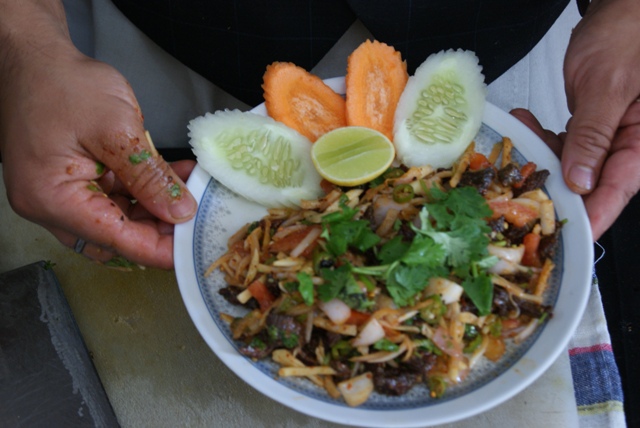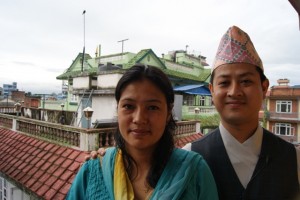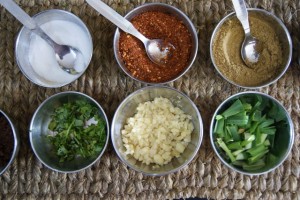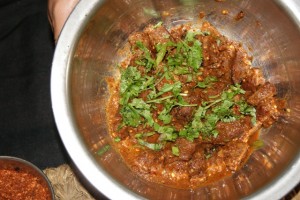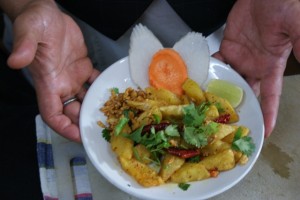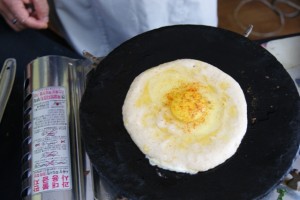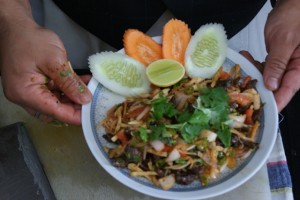Maheshwor is one of the growing breed of aware youngsters of Nepal – those who believe in their motherland and her capabilities. They take immense pride in their cultural and traditional heritage. Despite the recent upheavals in Nepal’s politics, he is gung-ho about his country’s potential to be a tourism hub in the region. ‘Why work under somebody in a strange country when you can be your own boss in your own country’ he told me when I asked him on why he came back from the land of black gold. Like most of the other Newars, the community where he belongs, Maheshwor too is enterprising and hardworking, earns his livelihood putting to use his skills as a restaurateur chef. That morning he promised to take me to his small but comfortable restaurant in Thamel and introduce me to the more popular among Newar dishes.
Nepal has a population of over 25 million with Kathmandu itself accounting for over two million people. Explosive urbanisation in the past two decades has led to indiscriminate expansion of the capital in all directions. Rice growing land and terraces have given way to industries and private residences. The city itself is sagging at the seams trying to accommodate migration from all parts of the country. There are more than 70 ethnic groups here who speak over 50 languages. The Newars are of Tibetan-Burmese origin and claim to be the original inhabitants of the valley. Maheshwor, a Newar, stays in the relatively new city of Gungapur which is on Kathmandu outskirts.The food habits change from region to region and depend on the respective climate, the available agricultural crops, religious beliefs and social status. Probably because their roots go back to predominantly mountain tribes, the typical Nepali eats a lot of meat. Rice remains the staple food and a significant source of energy. Since the introduction of potatoes by the British, the vegetable has found its way to many tables – boiled or baked, eaten with just salt, dipped in chillies or with cheese. Maheshwor started his day in office preparing choyela, a meat preparation, a local favourite that was very much in demand.
Choyela – ingredientsRed or white meat, cut to thick long strips
Red chillies
Salt
Cumin powder
Ginger garlic paste
Roasted mustard oil (a typical Newari flavour)
Tomatoes (to be barbecued with the meat – for tendering the meat)
Other innovative flavours which Maheshwor will not divulge
The strips of meat are barbecued over charcoal fire for 15 minutes. Giving the Maheshwor touch are the tomatoes which are placed along with the meat for tendering and giving them a tangy flavour. After the barbecue, the meat is transferred into an enclosed vessel where it is kept for five to 10 minutes. This is to allow for further tendering as well as for the flavours to sink in. The strips are now cut into small pieces. The burnt skin of the tomato is removed and mashed into a fine, watery gravy. Some of the ginger garlic paste is mixed into the meat pieces and rubbed in nice and deep. The mashed tomatoes are then added to it and mixed together. For 200 grams of meat, two teaspoons each of chilli, salt and cumin and ginger garlic paste is ideal, though some might opt for a little extra chilli. Three to four teaspoons of mustard oil is added to the mix for the flavour. Chopped coriander and garlic leaves are added for garnishing and voila it is choyela! (Sic)
In case the vegetarians are feeling left out, Maheshwor brings you another Newar special, the aloo or potato tareko.
Potatoes chopped into medium-size pieces
Soya bean or sunflower oil for frying the potatoes
Red chillies
Chopped garlic
Salt, Szechuan (Chinese) pepper, turmeric powder, red chilli powder, coriander leaves
Lemon, cucumber, carrot for garnishing
Be ready to eat a lot of oily stuff
Boiled potatoes are peeled and cut into medium pieces. These are then fried in oil to a golden brown. Dried red chillies and chopped garlic can also be fried along with the potatoes. The fried potatoes, red chillies and garlic are now sautéed with pinches of turmeric, Chinese or Szechuan pepper, salt and a dash of red chilli powder. Coriander leaves are also added for flavour and probably for some reassuring green. Garnish it with some lemon, carrot and cucumber and you have a gobsmacking snack ready. A filling one too.
The Nepalis have their own version of the Indian dosa. It is called the barra.
Lentil batter
Ginger garlic paste
Cumin powder, red chilli, salt
Egg or meat if you are not making a simple barra
Mustard oil (of course)
After soaking the black lentils overnight, the skin is removed. The lentils are then ground to a batter to which ginger garlic paste, cumin powder, salt and a spot of red chilli powder is added. Just like the Indian dosa, the barra too can be made in many ways. However, the most popular one is the egg barra which is made by breaking an egg over the barra and sprinkle some cumin and chilli powder to taste.
The Newars are predominantly meat eaters – which provide them with the much-needed supply of protein. Fried or dried, barbecued or boiled, both red meat as well as fowl is very much in demand. The next culinary delight was sandeko or sundried meat.
Sandeko – ingredientsSundried meat, usually buffalo
Onions, tomatoes – chopped
Green chilly coriander, garlic, ginger (shredded to small pieces), red chillies, cumin powder, salt
Concentrate lemon juice
Soya oil for frying
The sundried meat is soaked for a little while in water to make it more malleable and cut into small pieces. The chopped pieces are fried in soya or sunflower oil. The fried meat is tasty on its own and can be eaten as appetisers. To proceed to sandeko, add chopped tomatoes, onions, green chillies and coriander leaves. Long thin slices of garlic and ginger are added which gives the sandeko its distinctive pungent aroma. Red chilli powder, cumin and a touch of salt is added. Squeeze some lemon as well as some hot oil from the frying pan. Add some mustard oil for the flavour and then mix it all thoroughly together.
As Maheshwor was preparing the lovely delights, I managed to pull off a small surprise for him: Rabi Thapa, an ex journalist and an aspiring writer who recently brought out his first book. Rabi, during his days as a journalist with a leading newspaper was a regular at the Newar de Cafe. He used to prod Maheshwor into experimenting with his culinary skills. Rabi today, is a reasonably well-known face in the literary circles of Nepal and getting him to sample the dishy fare was not very easy. But getting him to approve the food was a piece of cake.Leaving the culinary delights of Newar de Cafe with burpy contentment, I decided to move on to more nocturnal pursuits. Historically Nepal has never let down the creatures of the night. Whatever the politics may dictate or the social fabric may mandate, the city is never short of guilty pleasures. Only that you have to look in the right places at the right time.
As dusk drew close to my last evening in Nepal, I was back in Thamel.


